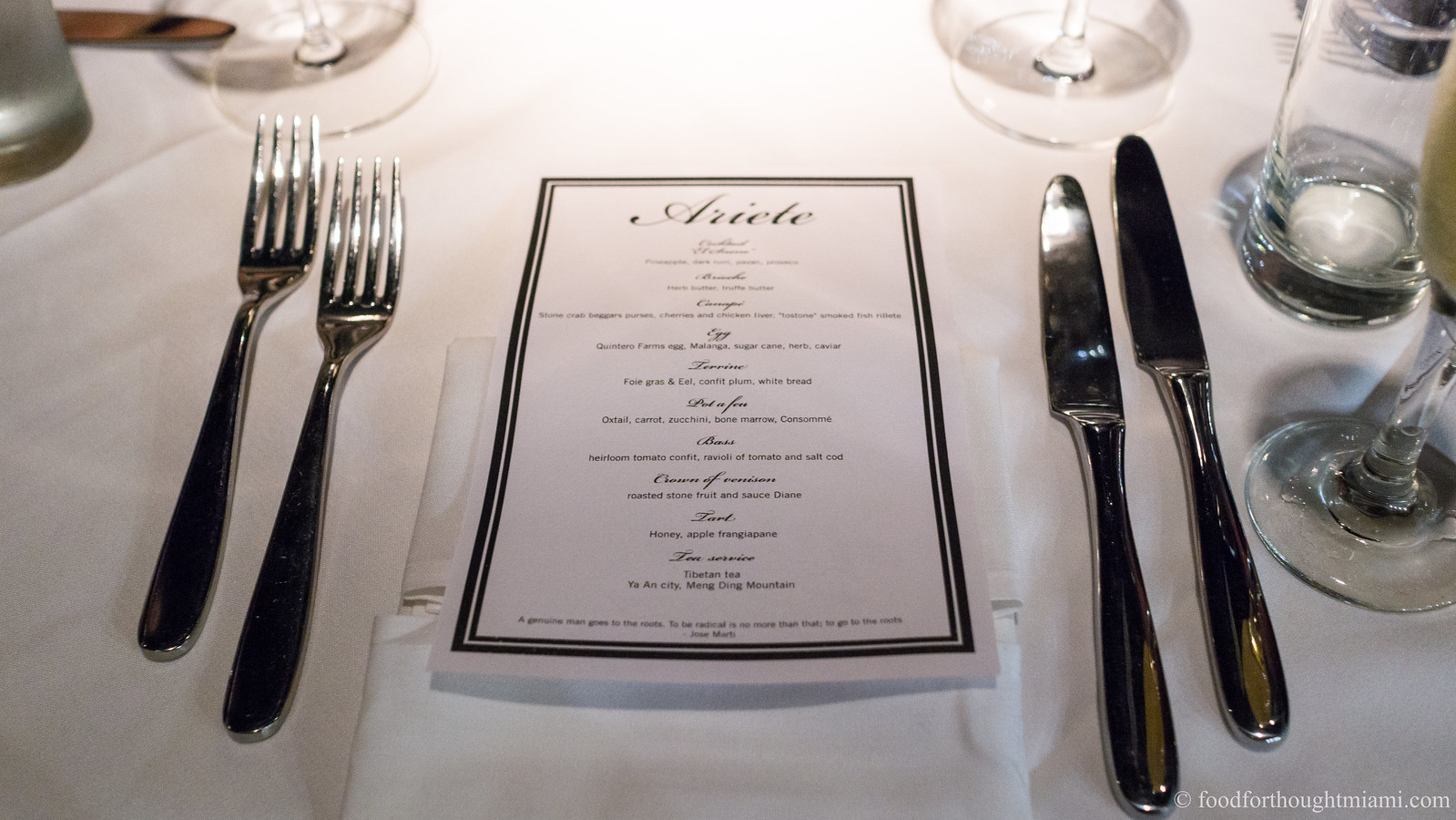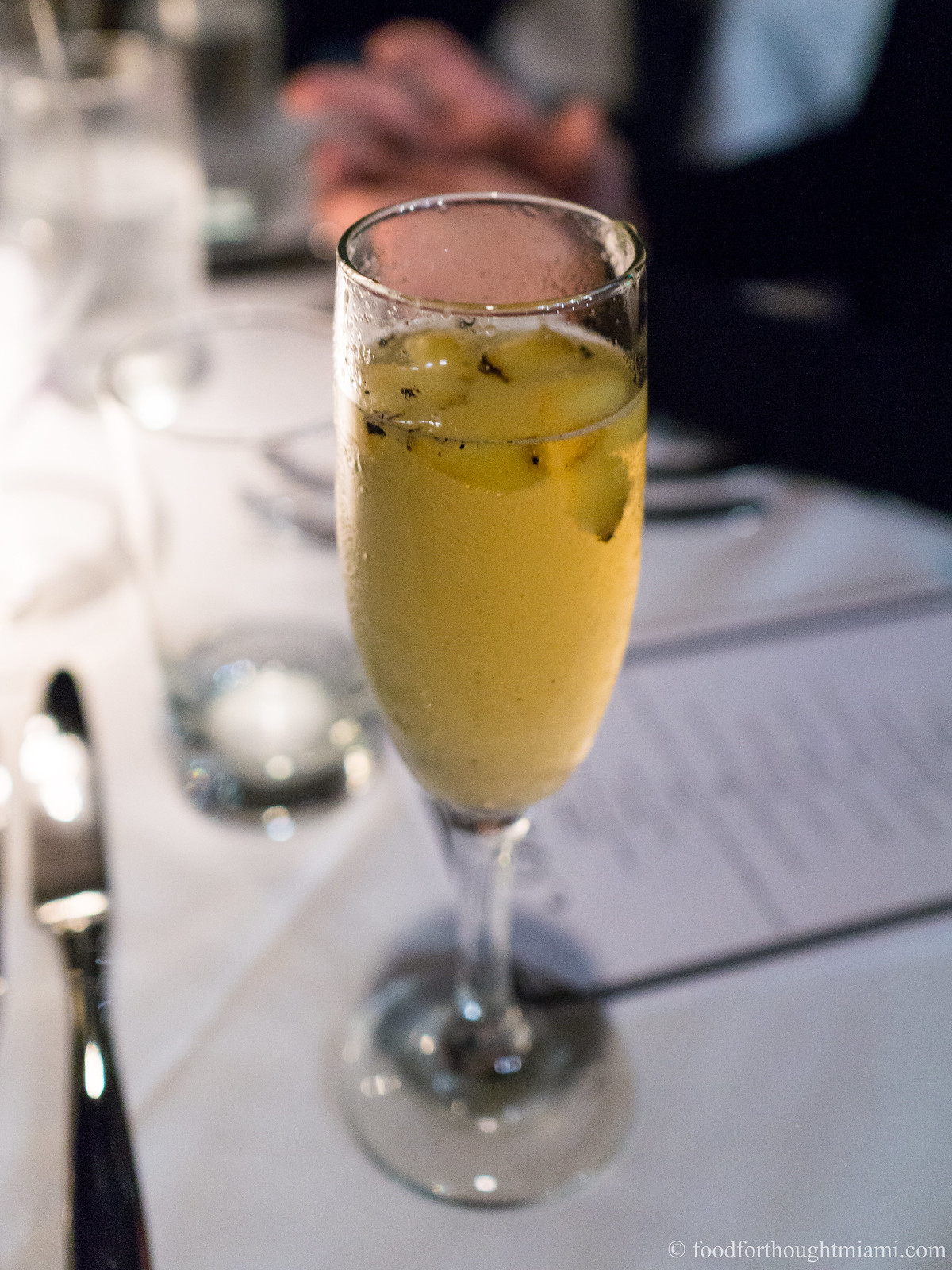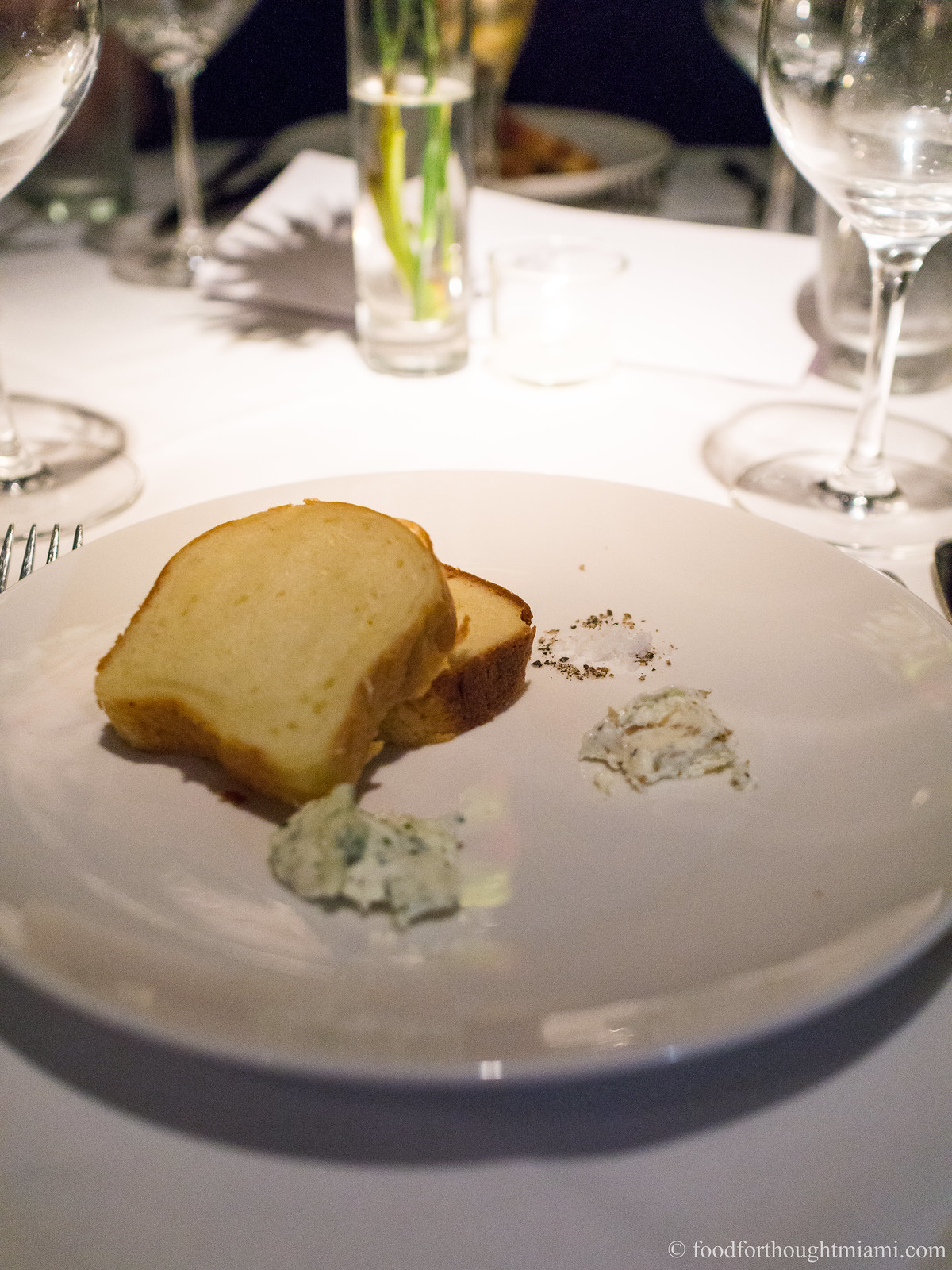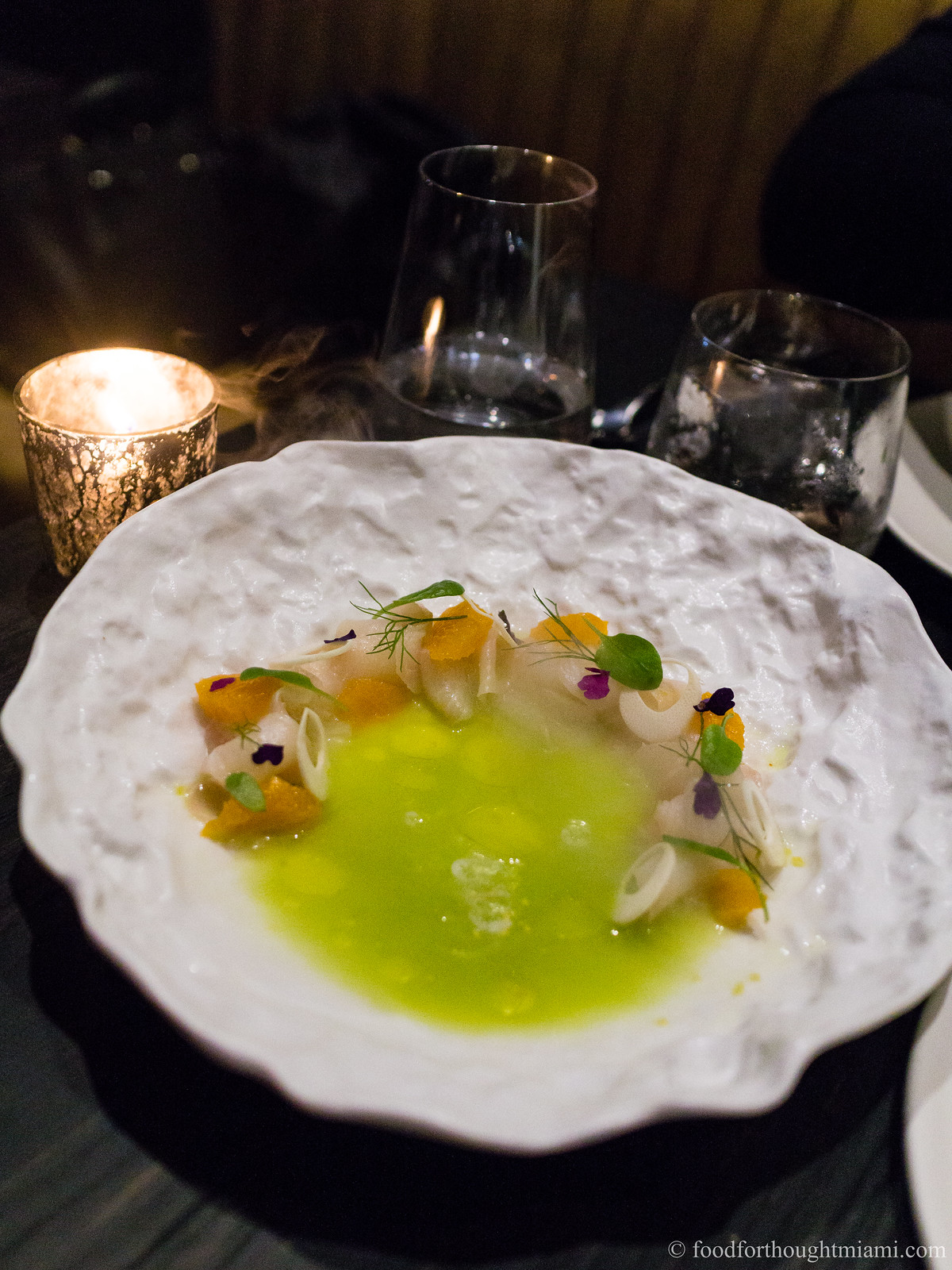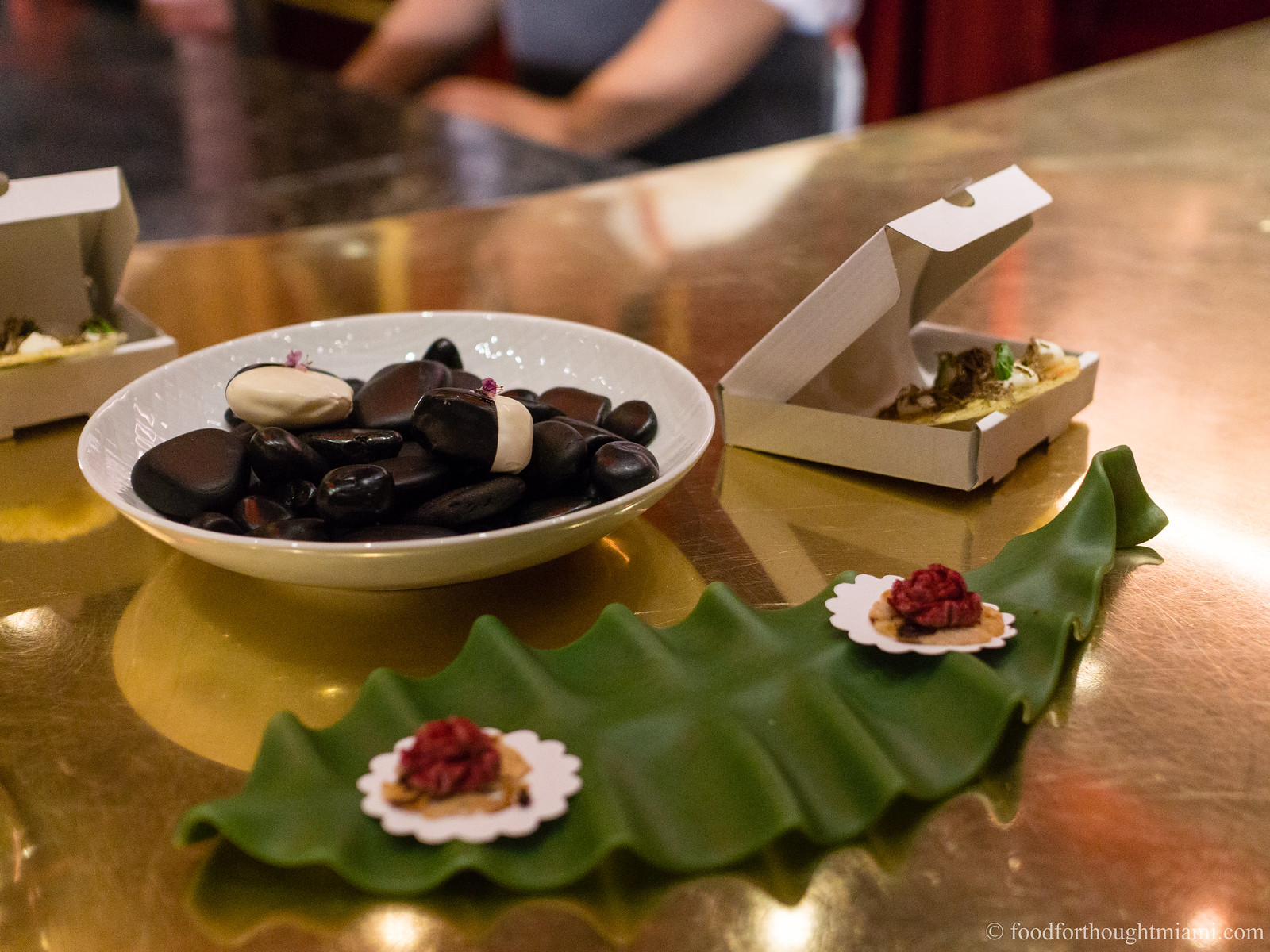Wednesday, December 20, 2017
Cobaya Ariete with Chef Michael Beltran
Cobaya's been on a long break, but we came back strong. Monday night, Chef Michael Beltran let us take over his Coconut Grove restaurant, Ariete, where he served forty of us an elegant eight-course dinner that hearkened back to another generation of fine dining. Canapés and terrines and consommés – nobody does this stuff any more![1] While I wouldn't want to dine like this every day, it was a beautiful reminder of what's been lost as we abandon the white linens for the unfinished wood tables and side towel napkins.
Ariete is usually one of those bare wood table kind of places – and a really good one, about which I've been meaning to write here at FFT. But for present purposes, let's focus on Monday's dinner.
(You can see all my pictures in this Cobaya Ariete flickr set.)
Upon getting to the restaurant a couple minutes before our early 6:45pm start time to check our guests in, I was shocked to find the entire dining room already filled and seated.[2] Chef Beltran was at the pass getting the first course ready, and looking as tightly wound as the rubber band on a balsa wood flyer. I told him to relax; he said he'd relax after service was over. It's one of the things I love about Mike – he's a sweetheart and a wise-cracker, but he's got an intensity and focus about his work that takes priority over everything else.
To start, a welcome cocktail – "El Sueno," with dark rum, pineapple, Pavan liqueur and prosecco – and a bread service of soft, yeasty brioche with a duo of butters – herb and truffle – and some coarse salt.[3]
Just the word "canapés" brings to mind posh dinner parties of a kind I've mostly only fantasized about; the closest we came when I was growing up was parties where my parents would make pitchers of frozen daiquiris and warm up little frozen puff pastry doodads. Here, Beltran made silky beggars' purses filled with picked stone crab, a crimson cherry filled with chicken liver mousse, and a crispy tostone topped with smoked fish rillettes. Fancy.
At his Paris restaurant l'Arpège, Chef Alain Passard serves a dish that is now universally known as "l'Arpège Egg" – a soft-cooked egg yolk cooked in the shell, seasoned with fleur de sel and snipped chives, topped with cold whipped cream, sherry vinegar and maple syrup, for a perfect combination of hot and cold, sweet and sour.[4] Beltran's ode to the dish incorporated some local flavors: a silky malanga purée and sugar cane, plus some caviar for good measure. It was delicious.
(continued ...)
Monday, November 13, 2017
first thoughts: Stubborn Seed | Miami Beach
Summer in South Florida isn't good for much. Mangoes. Avocados. Royal poincianas. That's about it. It's the season of 90° heat with 90% humidity, hurricanes, and restaurant closures.[1] But we've made it through to the other side! The thermometer occasionally dips below 80°, most of the trees downed by Hurricane Irma have been cleared, and new restaurants are popping up left and right. Among them is Stubborn Seed, which opened in late September. It is the first of two new projects[2] from chef Jeremy Ford, who was last heading up the kitchen at Jean-Georges Vongerichten's Matador Room, though many more folks probably know him from his victory in Top Chef Season 13.
This is a much more intimate affair than his last gig. Ford has traded a big hotel restaurant for a corner spot in South Beach's quieter SoFi (South of Fifth) neighborhood, where about sixty seats are divided between a bar area with high-tops as you enter and a somewhat stark dining room in back, all buffed gray walls and dark wood tables.
(You can see all my pictures in this Stubborn Seed flickr set.)
The menu at Stubborn Seed is somewhat stark as well: it comprises fifteen items all told, which includes a "bread service" that was brought to our table without charge.[3] It's matched by a cocktail selection that is nearly the same size – in fact, the actual drinks menu is in the form of a newspaper which dwarfs the size of the food menu.
The bread service and the cocktails are a good way to start things off at Stubborn Seed. The bread is a puffy version of Colombian pan de bono, dusted with fennel pollen and coarse salt, and served with a dollop of an herb-flecked green garbanzo dip whose bright color matches its flavor. And you'll want to spend some time with these cocktails, because they're a production. The "Negroni a la Ford" is made with Del Maguey Vida Mezcal in place of the gin, plus Ancho Reyes, white creme de cacao, and Xocolatl Mole bitters, as well as a passionfruit marshmallow suspended across the glass which you can toast over a flaming sugar cube.[4] The "Silver Dollar Old Fashioned" is a D.I.Y. project which literally arrives on a silver platter, with a cut-glass decanter of rye, a dropper of house-made bitters, a shaker of simple syrup, and a big ice block in a glass. There's a lot of ungapatchka here, but you could skip the s'mores and the silver platters and they'd still be very good drinks.
It's possible you've heard this before, but dishes "are meant to be shared," and "come out of the kitchen as they're ready." We ordered several of the crudos and "snacks" (which collectively make up 2/3 of the short menu) and one larger dish to share; happily, rather than the confused multi-plate pile-up that often ensues, our meal was coursed out in a series of rounds that actually made sense. But pity the diner who just wants their own appetizer followed by an entree these days.[5]
When Ford was on Top Chef, I nicknamed him "Crudo Bro," because every dish he made was a crudo,[6] and because he is clearly a member of the Broheim Tribe.[7] So we had to try both iterations featured on the menu. The one pictured at top was a winner: meaty, fatty Hawaiian kajiki (blue marlin), paired with creamy buttermilk and spicy fermented chiles, kombu, ribbons of Asian pear, and dried sea grapes. It was great.
The other, featuring local snapper cured in JoJo tea, with slivers of heart of palm and clementine segments, awash in a green bath of sorrel and celery, was dominated by the cloying sweetness of the clementine. This dish needs something to perk it up other than the smoke from dry ice added to the bowl.[8]
This lavash cracker, spread with chicken liver mousse and dotted with smoked chili jam, was just delicious – crunchy, creamy, rich, spicy, sweet. Shared between two people, it makes for only a couple bites, and may well leave you pining for another.[9]
(continued ...)
Wednesday, October 18, 2017
é by José Andrés | Las Vegas
There's a phenomenon on social media lately that whenever a celebrity chef expresses an opinion on political or social issues, a chorus of those whose sensibilities diverge insist that the chef should "stay in their lane." In other words, talk about food all you want, but keep your politics to yourself. The reaction seems inherently ridiculous to me – if you don't like it, the "unfollow" button is a simple, elegant solution – and hypocritical. Unless, that is, all these "stay in your lane" folks are actually career political scientists themselves, or perhaps professional life coaches.
I bring this up here because Chef José Andrés is a powerful retort to that kind of nonsense, someone whose talk has been backed up by meaningful, thoughtful action. The day after Hurricane Harvey cleared Texas, he was in Houston feeding people. A month later when Hurricane Maria decimated Puerto Rico, he was there within days serving meals. Over the past weeks, he's mobilized a brigade of food trucks and canteen kitchens to serve 100,000 meals a day, while getting minimal support from the federal government, in a territory with an almost entirely broken infrastructure.[1]
But this shouldn't come as a surprise. His charity work is not simply a reaction to recent events, but a commitment that dates back to at least 2010, when he founded a non-profit, World Central Kitchen, as a response to a devastating earthquake in Haiti. When, in mid-2016, then-candidate Trump described Mexicans as criminals and rapists, Andrés – an immigrant and naturalized U.S. citizen himself – didn't just gripe about it on Twitter. He pulled out of a multi-million dollar restaurant deal at a Trump property in DC, risking the inevitable lawsuit from the litigation-happy candidate. (Andrés countersued, and the case settled in April on undisclosed terms.)
All of which is to say: José Andrés can cruise in any lane he wants, as far as I'm concerned.
While the work he's doing now in Puerto Rico is infinitely more important, those lanes do actually include chef and restaurateur as well. Andrés' restaurants include the Michelin two-star Minibar, along with a mini-empire of places in DC, LA, Miami, and Las Vegas, the last of which I visited recently for a conference.[2] While there, I squeezed in a dinner at é by José Andrés, an 8-seat "restaurant within a restaurant" inside Jaleo at the Cosmopolitan.
(You can see all my pictures in this é by José Andrés - Las Vegas flickr set).
The format of é is patterned after the original iteration of Minibar in DC with a dollop of Vegas glitz. Its roughly 20-course tasting menu is unabashedly inspired by the creations of Andrés' mentor, Ferran Adrià, with whom Andrés worked at El Bulli in Spain before going on to tremendous success in the U.S. I'd visited é once before, though I hadn't realized how long ago it had been – nearly six years. The room, centered by a polished metal chef's counter surrounded by walls lined with tiny drawers and odd tchotchkes, hasn't changed much. One of the chefs said it was meant to make you feel like "You're inside Chef Andrés' head." (It kind of does.) The menu was almost entirely different, though there were some echoes of prior meals.
Guests are corralled at a table in Jaleo and offered a drink before the dinner at é starts. After a few minutes, the hostess divulges that the centerpiece on the table is also the first course: a cracker flavored with black olive, stuck with edible flowers.
Then upon entering the cloistered dining room, a cocktail: sangria, frozen and powdered to a slushie-like consistency, with compressed melon, sour cherry pearls, and fresh mint leaves.[3]
A cheese course of sorts: a soft-frozen manchego and beet rose topping a walnut cracker, "stones" of idiazabal cheese with a jamón and rosemary glaze nestled atop a bowl of river stones; and a "pizza" of San Simon cheese topped with oregano cream, dried tomato, and fresh shaved truffle.
(continued ...)
Subscribe to:
Posts (Atom)

